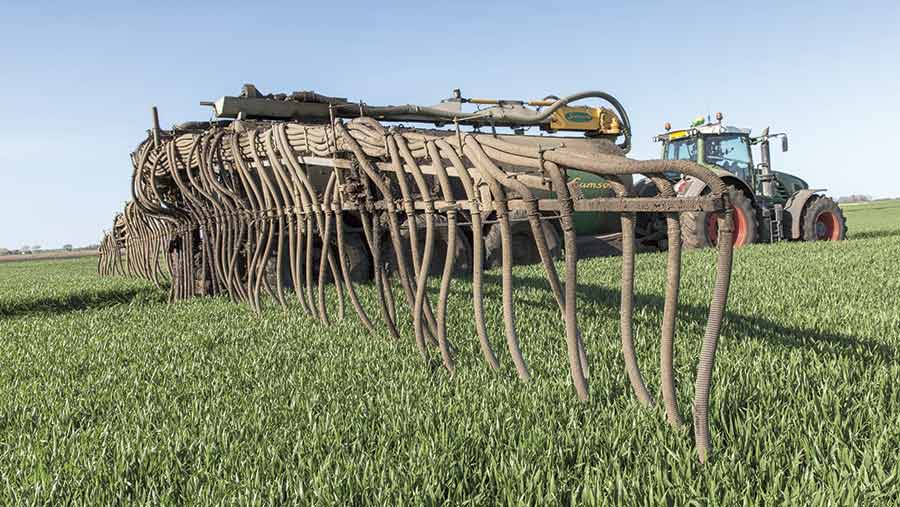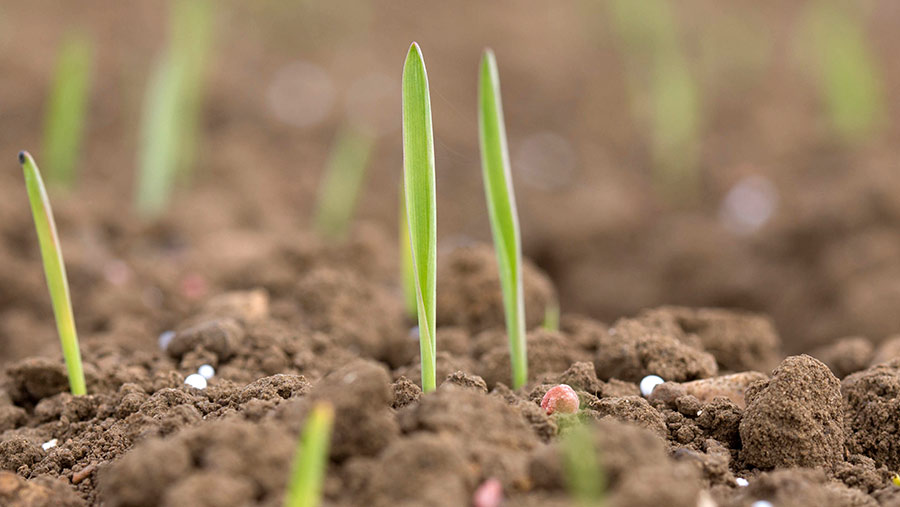Q&A: Tips on using anaerobic digestate as a fertiliser
 © Gary Naylor
© Gary Naylor Using anaerobic digestate to feed arable crops can save farmers up to £110/ha on bagged fertiliser costs. However, there are many rules on its application.
Getting it wrong will not only bring the risk of being on the wrong side of the law, but it can also have adverse affects on soil and the environment, such as reduced earthworm numbers when applied at too high a rate.
Farmers Weekly gets some advice from an independent expert on how to reap the benefits of using digestate, while avoiding any pitfalls.
Is all anaerobic digestate the same?
No, digestate is a byproduct of biogas production using organic materials and comes from two streams. The first is from anaerobic digestion (AD) plants fed using organic waste from the food sector, which may include supermarkets, processors and abattoirs.
The second stream is from farm-fed AD plants using specially grown crops such as maize or energy beet, along with manures or slurry.
See also: Guide to slurry assessment and application
With each stream, it can come in three forms. The most common is whole digestate, which has a dry matter (DM) content of 3-10%. This can be separated at the plant into a liquor of 1-6% DM and a solid fibre of 20-40% DM.
How can I assure its quality?
With digestate sourced from an AD plant fed with food waste, it is important to ensure that it is consistent and safe to use as a fertiliser on farmland.
As such, digestate from AD plants that comply with the quality protocol set out by the British Standard Institution’s publicly-available specification 110 (BSI PAS 110) are not classified as wastes.
This PAS 110-compliant digestate will be pasteurised for biosecurity purposes and meet standards for physical contaminants (for example, plastics and glass). A nutrient analysis is also required and available from its producer.
Non-PAS 110-compliant digestate must be applied to farmland under the Environmental Permitting Regulations.
Farm-based AD plants fed with crops, manures and slurries do not require a PAS 110 for their digestate, as it is not derived from waste.
A summary of the rules for application of PAS 110 digestate to land can be seen in the table below.
| When and where food-based PAS110 digestate can be applied to land | ||||||||
| BSI PAS 110 digestate | BSI PAS 100 Compost | |||||||
| Cropping category | Pasteurised | Non-pasteurised | Green | Green/food | ||||
| Combinable animal feed crops | Yes | May be applied before and after drilling | Yes | May be applied before and after drilling | Yes | May be applied before and after drilling | Yes | May be applied before and after drilling |
| Grassland and forage – grazed | Yes | Statutory no-graze intervals apply | Yes | Three-week no-grazing period applies | Yes | Three-week no-grazing period applies | Yes | Statutory no-graze intervals apply |
| Grassland and forage – harvested | Yes | Statutory no-harvest intervals apply | Yes | Three-week no-harvest period | Yes | Three-week no-grazing period applies | Yes | Statutory no-graze intervals apply |
Source: Wrap UK
What is its nutrient value?
Digestate is often referred to as “rocket fuel” and it has earned this tag from its high available nitrogen content when compared with livestock slurries.
As whole digestate, liquor and separated fibre can vary significantly in nutrient content depending on feedstock, digestion process and storage methods, it is always advised to have your digestate analysed before applying to land. This costs about £40-50 per sample.
Average nutrient content for digestate (kg/t) |
||||||
| Type | Stream | Dry matter (%) | Total nitrogen (%) | Total phosphorous (%) | Total potassium (%) | Total sulphur (%) |
| Whole | Food-based | 4.1 | 4.8 | 1.1 | 2.4 | 0.7 |
| Farm-sourced | 5.5 | 3.6 | 1.7 | 4.4 | 0.8 | |
| Separated liquor | Food-based | 3.8 | 4.5 | 1.0 | 2.8 | 1.0 |
| Farm-sourced | 3.0 | 1.9 | 0.6 | 2.5 | <0.1 | |
| Separated fibre | Food-based | 27 | 8.9 | 10.2 | 3.0 | 4.1 |
| Farm-sourced | 24 | 5.6 | 4.7 | 6.0 | 2.1 | |
Source: AHDB RB209 Nutrient Management Guide
Typically, the crop-available nitrogen from whole digestate or separated liquor applied in the spring is 55% of the total N. This falls to 15% if applied to cereals in the autumn.
For autumn applications to grass or oilseed rape – both crops that have an autumn N requirement – you should assume 35%.
With separated fibre, crop-available N is 10% of the total applied in the autumn and 15% in the spring.
How much can I save on bagged fertiliser?
Using the typical values for whole food-based digestate set out in the AHDB Nutrient Management Guide and applying 30cu m/ha to a winter wheat crop in spring on a sandy soil with a P index 2 and K index 2-, growers can save a significant £110/ha on artificial fertiliser application.
How and when should I apply it?
With a high readily available nitrogen content, digestate is susceptible to nitrogen losses via ammonia volatilisation into the atmosphere and nitrate leaching to water when applied in the autumn to crops with no N requirement.
To minimise losses and reduce odour, growers should aim to apply during good growing conditions using a band applicator or shallow injection system. Flow meters fitted to application equipment are essential to ensure that the correct rate is being applied in the right place.
Food-based digestate with a PAS 110 or farm-sourced digestate is subject to the closed-spreading periods for high readily available N manures in nitrate vulnerable zones (NVZ) (see table below).
| NVZ closed period for livestock slurries, digestate and poultry manures | |||
| Start date | End date | Land use | Soil type |
| 1 August | 31 December | Tillage land | Shallow or sandy soils |
| 1 September | 31 December | Grassland | Shallow or sandy soils |
| 16 September | 31 December | Tillage land with crops sown on or before 15 September | Shallow or sandy soils |
| 1 October | 31 January | Tillage land | All other soils |
| 15 October | 31 January | Grassland | All other soils |
Source: NFU

© Tim Scrivener
What effect will it have on my soil?
Trials conducted as part of the Digestate and Compost in Agriculture (DC-Agri) project tested organic materials and their impact on several soil properties over a three-year period.
With the high ammonia levels found in liquid digestate, there was some evidence that high rates of around 50cu m/ha can affect earthworm numbers.
Applying digestate at more “sensible” rates of 20-30cu m/ha will reduce the risks. This will also help reduce the likelihood of in-crop problems such as scorch or lodging where excess N is applied.
With a very low DM content, whole digestate or liquor is unlikely to have a significant impact on soil organic matter, so bulkier materials such as compost or farmyard manures should be used if soil conditioning is the aim of application.
View from the field: Contractor tips for digestate application
Most digestate applications to arable crops and grassland in the UK are carried out by a specialist contractors, such as Suffolk-based Tramspread, which applies more than 300,000cu m/year across East Anglia and beyond with an umbilical system.
The firm’s Terry Baker offers some additional practical advice for farmers preparing for digestate applications to their land this spring.
Know what you are applying – Having accurate analysis is vital to know what you are putting onto the land, particularly regarding nitrogen. This will allow digestate to fit smoothly into nitrogen plans during the spring.
Anaerobic digestion plants should have nutrient analysis of their product. “However, contractors like us will use the Agros slurry testing kit for quick and accurate N testing on-farm. Where a more detailed analysis is required for P, K and micronutrients, we can send digestate to a lab.”
Provide drainage maps – Where land is drained or sloped, it is useful to provide contractors with accurate field and drainage maps highlighting any watercourses. This will help monitor flows and manage application to avoid the digestate causing an environmental hazard.
Apply to a growing crop – With such high nitrogen availability, digestate is best applied to a growing crop during the spring for optimum utilisation. You can apply up to 30cu m until 1 March, and up to 50cu m thereafter. Rates can be split down to fit nutrient plans or account for ground conditions.
Utilise the latest technology – Dribble bars are the best universal application method for digestate in maize and cereal crops, while a trailing shoe is useful in grassland systems and prevents potential contamination of silage.
Flow meters and GPS application mapping help with accurate spreading and record keeping. It is early days for section control and variable rate application, but most current systems allow manual shut-off and control of flow rates to avoid over-application on headlands and corners. The key is even application across the field.
Manage storage effectively – While changes to storage aren’t necessarily practical, AD plants and farms should do all they can to provide easy access to digestate and slurry stores and lagoons for application.
Further reading
For more information on digestate and its application go to the Wrap UK website or visit the Biofertiliser Certification Scheme website

